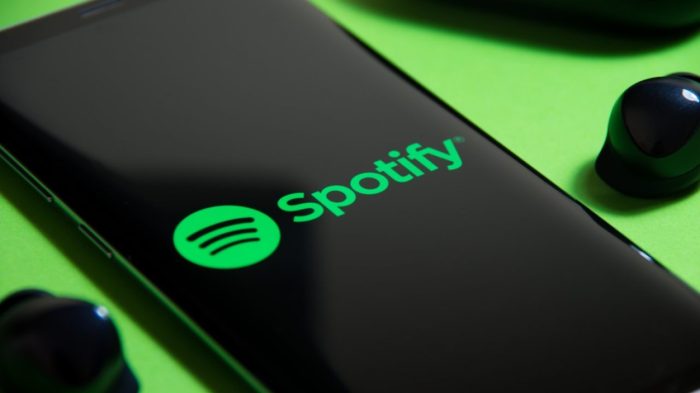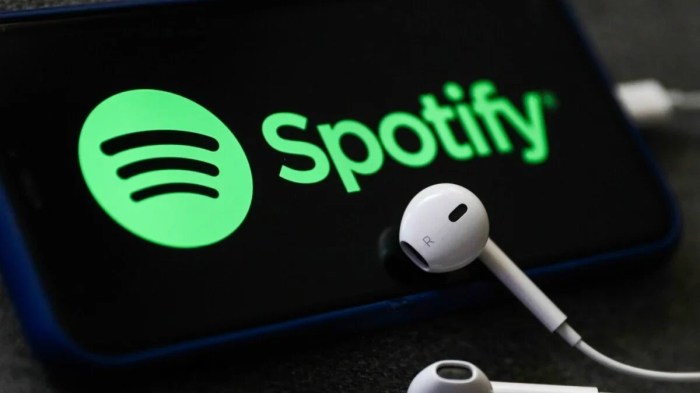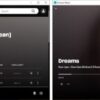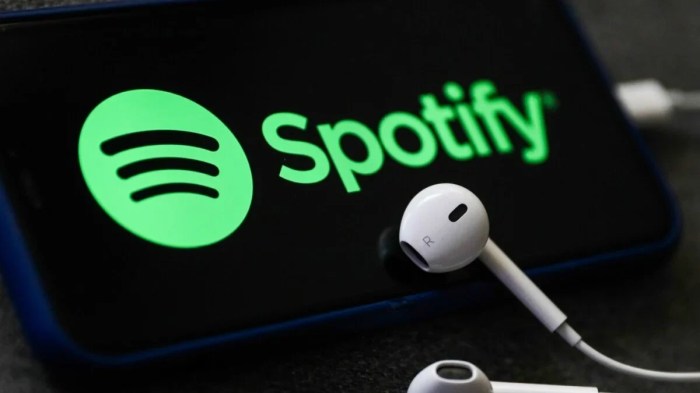Spotify tests offline mix feature, promising a revolutionary way to enjoy music. Imagine effortlessly building your own personalized offline music mixes, tailored to your mood and perfect for your commute or a long flight. This new feature could change the way we listen to music, offering unprecedented flexibility and control over our auditory experience. But what are the potential downsides?
What technical hurdles need to be overcome? Let’s explore the possibilities and potential pitfalls of this exciting new development.
Spotify’s testing of this feature suggests a deeper understanding of user preferences. Users often want control over their listening experience, and the ability to curate and enjoy offline mixes would be a significant step in that direction. Other music streaming services have experimented with offline listening, but the unique aspect of this is the potential to create personalized mixes directly within the platform.
Introduction to Offline Mix Feature
Spotify is reportedly testing an offline mix feature, allowing users to download curated playlists or radio stations for listening without an internet connection. This is a significant development, potentially offering a more convenient and flexible music listening experience. The feature could prove particularly useful for users with limited data access or unreliable internet connectivity.This new feature, if implemented, would likely have a considerable impact on how users interact with Spotify, potentially changing the balance between streaming and offline listening.
The specifics of the feature’s design, including the types of mixes available for offline download, are still under development and have not yet been publicly disclosed.
Potential Benefits for Users
The ability to download curated mixes offers several potential advantages. Users can now enjoy music without incurring data charges, especially helpful in areas with limited or expensive mobile data plans. This is especially valuable for travel, commutes, or situations where a consistent internet connection is unavailable. The offline mix feature also allows for more personalized listening experiences, potentially offering users the opportunity to pre-load content for situations where access to streaming services might be limited or unreliable.
Potential Drawbacks for Users
While the offline mix feature holds significant promise, potential drawbacks exist. Storage space is a critical consideration. Downloading large mixes could quickly consume significant storage capacity on a user’s device. Users will need to be mindful of the size of the mixes they download to avoid filling up their storage. Another consideration is the potential for the feature to limit the freshness of listening content.
Offline mixes, by definition, are static, potentially excluding the latest releases and trending music.
Examples of Similar Offline Features in Other Music Streaming Services
Several other music streaming services already offer offline playback capabilities. Apple Music, for example, allows users to download entire albums or playlists for offline listening. Tidal also provides offline downloads for users to enjoy music without a constant internet connection. These features are generally well-received by users seeking flexibility in their music consumption. The offline listening functionality in these competitors serves as a point of reference for the potential success or shortcomings of Spotify’s proposed feature.
They indicate a growing demand for this kind of functionality among music streaming users.
Technical Aspects of Offline Mixes
Spotify’s offline mix feature demands a robust technical infrastructure to handle the download, storage, and playback of audio content without a constant internet connection. This involves intricate processes that must be seamlessly integrated with the existing platform. Efficient data management is crucial to ensure a smooth user experience, especially when dealing with large-scale downloads and playback.The ability to access music offline requires significant technical preparation.
This includes the development of a robust download system, ensuring high-speed downloads, and a storage mechanism to hold large quantities of music files. Moreover, a system for efficient file retrieval and playback needs to be put in place to avoid any hiccups. The complexity arises from maintaining data integrity, particularly in large-scale operations and managing diverse user needs.
Technical Infrastructure for Offline Mixes
The core infrastructure for offline mixes comprises several interconnected components. These include a robust download server capable of handling concurrent downloads, a secure storage system with high availability and redundancy, and a playback engine optimized for offline content. The servers need to be scalable to handle surges in user demand, and the storage system must be able to accommodate large volumes of audio data.
The playback engine must be capable of quickly retrieving and decoding files, offering a seamless transition between online and offline playback.
Data Integrity Challenges in Offline Mixes
Maintaining data integrity for offline mixes presents several challenges. Corrupted files, synchronization errors during download, and inconsistencies in metadata can lead to a frustrating user experience. Ensuring that downloaded files are identical to the original streaming versions is paramount. Furthermore, the system must be able to detect and handle these errors efficiently to provide a reliable offline experience.
Spotify’s testing of an offline mix feature is pretty cool, isn’t it? It’s a smart move, especially considering how much people rely on music for their daily grind. Speaking of cool tech, this flying electric boat, this flying electric boat wants to be the tesla of the sea , is pushing the boundaries of water travel. While that’s impressive, I’m still more excited about the potential of having my entire Spotify library available without an internet connection, even for those long commutes.
Managing Large Amounts of Offline Mix Data
Efficient management of large amounts of offline mix data is crucial for a smooth user experience. The system needs to support a robust storage solution capable of handling vast quantities of audio files while maintaining quick retrieval times. Data compression techniques, optimized storage protocols, and intelligent caching mechanisms can help minimize storage requirements and improve playback speeds. For example, employing advanced compression algorithms can significantly reduce storage space without sacrificing audio quality.
File Formats for Offline Mix Storage and Streaming
Different file formats offer varying trade-offs in terms of storage space, playback quality, and compatibility. The choice of file format should balance these factors to provide the best possible user experience. For instance, using lossy formats like MP3 or AAC for offline storage might reduce file size but could compromise audio quality compared to lossless formats like FLAC.
Streaming formats like Ogg Vorbis might be optimized for certain playback scenarios but not necessarily for large-scale offline downloads. Consideration must be given to the trade-offs in each format.
User-Generated Playlists and Offline Mixes
User-generated playlists play a significant role in the offline mix feature. Allowing users to download their curated playlists for offline listening enhances their flexibility and personalization. However, maintaining the integrity of these playlists, including the order and selection of tracks, needs careful consideration. This necessitates a mechanism for accurately mirroring the playlist structure in the offline version, ensuring users have the same listening experience, regardless of internet connectivity.
User Experience and Interface Design

The user experience (UX) for offline mixes is critical to Spotify’s success. A smooth and intuitive interface will encourage users to leverage this feature, fostering a positive user experience and ultimately increasing engagement with the platform. A well-designed interface will empower users to efficiently create, manage, and enjoy their offline mixes without frustration.
User Interface for Accessing and Managing Offline Mixes
The offline mix interface should be easily accessible and integrated seamlessly with the existing Spotify design language. A dedicated “Offline Mixes” folder, clearly visible within the library section, will serve as the central hub for managing downloaded content. This dedicated space should provide a clear visual representation of the mixes, including their names, estimated download sizes, and any relevant metadata.
A simple, yet informative visual indicator, like a download icon next to the mix name, will help users distinguish downloaded mixes from those that need to be downloaded.
Spotify’s testing of offline mix features is pretty cool, offering more flexibility for listening on the go. While I’m intrigued by that, I also have to admit, a stunning wireless charger like the Bourge Design Wireless Charger Venus, beautiful and expensive , is a definite luxury item. Still, I’m more excited to see how Spotify’s offline mixes will improve my listening experience overall.
User Experience for Creating, Sharing, and Deleting Offline Mixes
Creating an offline mix should be a straightforward process. A prominent “Create Offline Mix” button, possibly with a plus icon, should be readily available within the playlist creation section or within the context of an existing playlist. Users should be able to select songs, albums, or artists to include in their offline mix. Sharing offline mixes with friends should also be an intuitive action, potentially using the same social sharing tools Spotify already employs.
The deletion process should be similarly straightforward, using a delete button or an option within the context menu for the mix. A confirmation dialog, ensuring the user’s intention, is essential to prevent accidental deletions.
Examples of Error Messages and Handling for Offline Mix Issues
Effective error handling is crucial for a positive user experience. If a song in a mix is unavailable for download, a clear message should be displayed, perhaps highlighting the reason for the issue, such as a copyright restriction or a temporary server problem. An option to automatically exclude the problematic song or to manually replace it with a similar track should be presented.
If the download fails due to insufficient storage space, a notification should be presented clearly, providing instructions for freeing up space. This message should be actionable, guiding users towards solutions such as deleting unnecessary files or using cloud storage.
Table of User Interface Elements for Managing Offline Mixes
| Element | Description | Example |
|---|---|---|
| Offline Mix Folder | A dedicated folder within the library for storing offline mixes. | A visual representation of a folder with a download icon. |
| Mix Creation Button | Initiates the creation of a new offline mix. | A button with a plus icon labeled “Create Offline Mix”. |
| Play/Pause Button | Controls playback of the offline mix. | A play/pause icon within the mix player. |
| Shuffle/Repeat Options | Controls playback options like shuffle and repeat. | A toggle switch for shuffle and repeat. |
Data Management and Storage: Spotify Tests Offline Mix Feature
Offline mixes are a powerful feature, but they demand careful consideration of data management and storage. Spotify needs a robust system to handle the increasing volume of user data associated with these mixes. Efficient storage and retrieval are critical for a smooth user experience, and security is paramount to protect user data. Furthermore, the system needs to be scalable to accommodate future growth and evolving user needs.This section delves into the intricacies of how Spotify can manage user data for offline mixes, from privacy concerns to the technical demands of storage and download processes.
A well-designed system will ensure seamless access to offline mixes, even with significant data volumes.
Spotify’s testing of an offline mix feature is pretty cool, especially for commutes or flights. But, if you’re finding your Chromebook’s web browser lagging, consider checking out how make your chromebook web browser even faster for some easy tweaks. These tips will likely speed up your browsing experience, which in turn might improve the overall performance of apps like Spotify, even if it’s not directly connected to the offline mix feature.
Data Handling for Offline Mixes
Spotify needs a system for organizing user offline mixes that efficiently categorizes and retrieves them. This includes unique identifiers for each mix, linking them to the user’s account. A relational database structure is likely ideal, enabling queries to locate specific mixes, playlists, or albums quickly. Data integrity is crucial to ensure that downloaded mixes are correctly linked to the user’s account and available for playback.
Privacy Concerns with Offline Mixes
Privacy is a paramount concern. Offline mixes contain user-selected music, and protecting this sensitive information is critical. Spotify must comply with all relevant data protection regulations, such as GDPR, and implement robust security measures to prevent unauthorized access or breaches. This includes end-to-end encryption for data transfer and storage. Auditing user access to and manipulation of offline mixes is also essential for compliance and security.
Storage Requirements and User Profiles
Storage requirements vary significantly based on user preferences and the size of the offline mixes. A user who downloads entire albums or playlists will require more storage than one who primarily downloads individual tracks. Spotify should provide a way for users to manage storage space, perhaps by setting limits or providing options for managing storage allocation. Estimating storage requirements could involve analyzing average user download habits and the size of various audio formats.
Download and Update Processes
Downloading and updating offline mixes must be efficient and user-friendly. A clear progress indicator, providing feedback on download completion and update status, is vital. The system should handle potential interruptions during downloads, allowing users to resume from where they left off. A robust error-handling mechanism will be essential to deal with potential issues during downloads, such as network interruptions.
Background Download System
A background download system is essential for managing offline mixes. This enables downloads to occur in the background, without interrupting other user activities, such as listening to music or using other applications. This ensures a smooth user experience, especially for large offline mixes. The background download system needs to intelligently manage available network bandwidth to avoid impacting other services and user experience.
Integration with Existing Spotify Features
Spotify’s offline mix feature aims for seamless integration with existing functionalities, enhancing the overall user experience. This integration ensures a consistent and intuitive experience, allowing users to effortlessly transition between online and offline content, and further personalize their music consumption. This is crucial for maintaining user engagement and satisfaction.
Integration with User Playlists
The offline mix feature is designed to coexist harmoniously with user playlists. Users can add offline mixes to their existing playlists, allowing for flexible organization of their music library. This approach empowers users to curate their music collections effectively, combining their preferred mixes with existing playlist structures.
Impact on Music Recommendations
The introduction of offline mixes won’t fundamentally alter Spotify’s existing recommendation algorithms. However, listening patterns from offline mixes will contribute to future recommendations. For example, if a user consistently listens to an offline mix featuring artists A and B, Spotify’s algorithm will likely recommend similar artists and songs in future recommendations. This refinement ensures that recommendations remain relevant and cater to user preferences, both online and offline.
Offline Mix Sharing
Spotify’s offline mixes can be shared with other users through existing social features, enabling collaborative music discovery. This allows users to share their meticulously curated mixes with friends and family, promoting social interaction and the exploration of new music.
Seamless Transitions Between Online and Offline Playback
A key aspect of the offline mix feature is the smooth transition between online and offline playback. The system will seamlessly switch to offline playback once the mix is downloaded. A user experiencing an offline mix will encounter no jarring interruptions or noticeable delays when returning to online playback. This seamless transition avoids any disruptions in the user’s listening experience.
For example, a user listening to a specific track within a downloaded offline mix will experience a seamless transition to online playback when they continue to the next track in the mix, if it is not available offline.
Potential Marketing Strategies

Spotify’s Offline Mix feature presents a unique opportunity for significant user engagement and increased platform usage. Effective marketing strategies are crucial to highlighting the benefits of this feature and driving adoption. A well-defined campaign can position Offline Mix as a compelling tool for users, encouraging exploration and deeper engagement with the platform.
Marketing Campaigns for Offline Mix
Successful marketing campaigns for the Offline Mix feature should focus on showcasing its value proposition. Highlighting the convenience and flexibility it provides is key. This involves demonstrating how users can utilize the feature for various scenarios, such as commutes, workouts, or travel. Emphasizing the quality of the offline mixes, highlighting features like curated playlists and personalized recommendations, can further enhance appeal.
Promotional Strategies to Attract Users, Spotify tests offline mix feature
Promotional strategies for the Offline Mix feature should aim to create a buzz around the functionality. Limited-time offers, such as exclusive access to offline mixes for a period, can incentivize early adoption. Partnerships with relevant brands or organizations, like fitness studios or travel companies, could offer complementary promotions. Targeted advertising campaigns on platforms frequented by the target demographic can effectively reach potential users.
Role of Social Media in Promoting the Feature
Social media plays a pivotal role in promoting the Offline Mix feature. Creating engaging content showcasing the feature’s benefits through visually appealing posts and short videos can generate interest. Running contests and giveaways on platforms like Instagram and TikTok can increase visibility and user participation. Leveraging user-generated content by encouraging users to share their experiences with the feature can amplify its reach and credibility.
Influencer marketing can also significantly impact awareness and adoption.
Influencer Marketing Strategies for Offline Mix
Collaborating with relevant music enthusiasts, podcasters, or lifestyle influencers can generate significant buzz. These influencers can showcase the Offline Mix feature in their content, providing genuine reviews and recommendations to their followers. Creating customized offline mixes for specific influencers can provide unique content, while ensuring the influencer is genuinely interested in the feature and the value it offers.
Collaborations with fitness influencers can showcase the feature’s usefulness during workouts. Cross-promotion opportunities with relevant influencers can further expand the reach of the feature.
Marketing Channels for Promotion
The table below Artikels various marketing channels for promoting the Offline Mix feature, highlighting their specific target audiences.
| Channel | Description | Target Audience |
|---|---|---|
| Social Media | Utilizing platforms like Facebook, Instagram, and Twitter to share engaging content, run contests, and leverage user-generated content. | Active social media users, music enthusiasts, and general Spotify users. |
| Email Marketing | Targeted email campaigns to existing Spotify users, highlighting the new Offline Mix feature and its benefits. | Existing Spotify users, particularly those who actively use the platform. |
| Blog Posts | Creating articles and blog posts on the Spotify blog and partner sites, showcasing the Offline Mix feature and its unique value proposition to music enthusiasts. | Music enthusiasts, podcast listeners, and individuals interested in music technology. |
Future Implications and Developments
The offline mix feature, once fully integrated into Spotify, holds significant potential for future growth and adaptation. Beyond its immediate value proposition, the feature opens doors to innovative applications and profoundly impacts user experience and the music industry itself. Its ability to seamlessly integrate with existing Spotify features is crucial for a smooth transition and user adoption.
Potential Future Developments
Spotify can leverage the offline mix feature by expanding its functionality beyond simple playback. This could include features like personalized mix creation based on user listening history and preferences, enabling users to generate their own custom offline mixes tailored to specific moods or activities. The incorporation of collaborative features, allowing users to share and combine their offline mixes, is also a potential area for development.
This would add a social element to the feature, encouraging community interaction and the creation of unique and diverse mixes.
Adaptation for Different User Needs
The offline mix feature can be adapted for diverse user needs by introducing different mix types. For example, a “Focus Mix” could be created for users wanting to eliminate distractions while working or studying. This mix could be tailored to eliminate certain genres or artists based on user preferences. Similarly, a “Travel Mix” could curate mixes based on locations, or even allow users to upload their own travel playlists, ensuring that the offline mix adapts to the specific context and needs of the listener.
Impact on the Music Industry
The offline mix feature could potentially impact the music industry by fostering new avenues for music discovery and consumption. Users might discover new artists or genres within the curated mixes, leading to increased listening and engagement. The feature could also enable a new approach to music licensing, potentially allowing for more flexible and nuanced licensing models for offline mixes.
Improvements to Offline Mix Playback Quality
Enhancements to offline mix playback quality are essential to maintain user satisfaction. This could involve optimizing the compression algorithms used for audio files, resulting in higher quality audio without significant increases in file sizes. Furthermore, improving the buffer management system for seamless playback, especially during transitions between songs, would create a more enjoyable listening experience. Implementing a feature that allows users to select different audio quality levels would offer a balance between file size and playback quality.
Hypothetical Scenario: Offline Travel
Imagine a user planning a road trip across the country. They could create an offline mix tailored to the specific destinations they’ll be visiting. For instance, if they’re traveling through the American Southwest, they could create a mix featuring regional artists, incorporating genres like country, blues, and folk, and adding songs that evoke the landscapes they’ll encounter. This tailored offline mix, accessible even without an internet connection, ensures a unique and immersive listening experience during their journey, enhancing their travel experience.
Ultimate Conclusion
Spotify’s offline mix feature, while still in testing, holds immense potential. The ability to create custom offline mixes, combined with seamless integration into existing Spotify features, could be a game-changer. The challenge lies in balancing user experience with the technical complexities of managing large amounts of offline data. Spotify’s success will depend on its ability to navigate these challenges and deliver a truly valuable experience for music lovers.
Only time will tell if this feature will be widely adopted and embraced.





